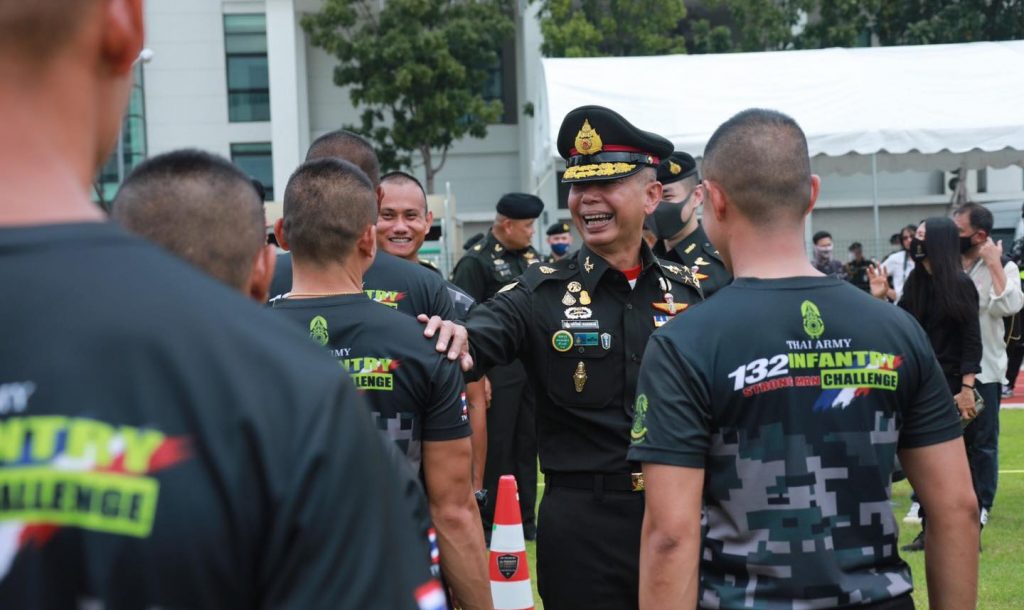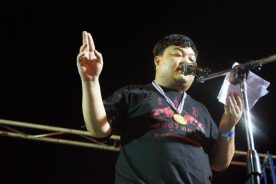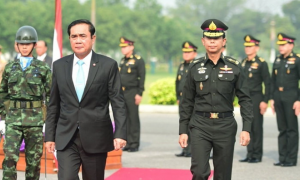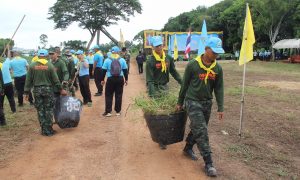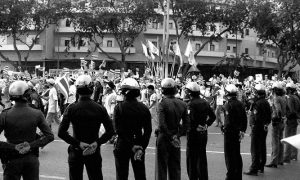As protests on the streets and opposition in parliament intensify in Thailand, Prime Minister (retired General) Prayuth Chan-ocha will increasingly look to the armed forces to retain power. But the army may not continue supporting Prayuth given a growing number of soldiers see him as slow to crack down on protestors, which the army perceives as inimical to the palace and armed forces. At the same time, the military has become increasingly factionalised and Prayuth’s clique is diminishing in influence among senior officers.
Thailand’s 19 September 2020 announcement of the 1 October armed forces reshuffle demonstrates these conclusions. In fact, a transition in Thailand’s military leadership has been taking place since the passing of the previous monarch in 2016. As I stated last year in New Mandala, persistence and change in the military hierarchy are often best reflected in yearly military appointments. Thailand’s 2020 annual reshuffle is no different. 782 appointments (19 of which are women) involved 482 officers of at least the ranks Army Major General (185), Navy Rear Admiral (163), and Air Force Air Vice Marshal (134), making for another year of a senior-officer, top-heavy military.
Since 2008 (following legal changes as a result of the 2006 coup), the reshuffles have been determined by a committee vote of members of the Defence Council (Commanders of the Army, Navy, Air Force and Royal Thai Armed Forces Headquarters as well as the Defence Permanent Secretary, Defence Minister and Deputy Defence Minister). It is a process meant to favour armed forces preferences, while stifling civilian control.
However, unlike the previous monarch who tended to balance out factions, the current king has been proactive in pressuring for his preferred candidates to lead the security services. Royal efforts have successively produced two personal palace favourites in the post of Army Commander: Generals Chalermchai Sitthisart (2016-18) and Apirat Kongsompong (2018-20). This palace penchant directly contributed to the weakening of the then-dominant army faction Buraphapayak (the Second Infantry Division “Eastern Tigers”)—the faction of Prayuth, Deputy Prime Minister General Prawit Wongsuwan and Interior Minister General Anupong Paochinda.
Buraphapayak was the leading army faction from 2007 until 2016. But the traditionally dominant faction had been Wongthewan (“Divine Progeny”), a clique led by elite military families dating back to 1870, representing the 1st Division, King’s Guard. Almost all previous Thai military strongmen were members of this faction, including Generals Plaek Phibunsongkram, Sarit Thanarat, Thanom Kittikachorn, Praphas Charusatien, Krit Sivara and Suchinda Kraprayoon. But when Thaksin Shinawatra became prime minister in 2001, he was able to incorporate many of its members under his sway. The result was that Buraphapayak was favoured by Thaksin’s foe, then-Privy Council Chair General Prem Tinsulanonda, to lead the 2006 coup.
Because the current monarch previously commanded various units within the King’s Guard, he is considered close to Wongthewan. Since becoming king, he has promoted Wongthewan military officers such as Apirat.
But recently, a new special royalist faction—revolving around the King’s Royal Guard 904 and derived from Wongthewan—has become the dominant army clique. The group is known as the “Tahan Kaw Daeng” (Red Rim Soldiers) and takes its name from the red-rimmed t-shirts which they wear during and upon completion of a gruelling three-month Elite King’s Guard training program. Officers from any unit or faction can enter the program and after graduation can claim a connection to the palace as Royal 904 soldiers. Passing the program makes them much more competitive candidates for the top-most army and armed forces postings.

Prime Minister Prayuth Chan-ocha (centre) showing respects to royalty. Image credit: National News Bureau of Thailand
The creation of the Red Rim Soldiers aims to establish greater army cohesion around loyalty to the monarch. Red Rim Soldiers are increasingly being promoted to command positions in the army and armed forces (see Tables 1, 2 and 3).
This week’s 2020 reshuffle was uncommonly important because all five “Five Tigers” at the highest level of Thailand’s security services, as well as all heads of Thailand’s four regional commands, retired simultaneously. Their replacements were all individuals with credentials linking them to the regal institution.
The ten demands that shook Thailand
Behind the student protests for reforms to the monarchy that are shaking the century-old foundations of Thailand's political system.
Succeeding Apirat as Army Commander is Red Rim/Wongthewan Gen. Narongphan Jitkaewthae. Narongphan’s elevation through the ranks has been extremely rapid since the beginning of the current reign. He is the former commander of the Royal Rachawallop 904 Special Military Task Force and considered extremely loyal to the current monarch. He is rumoured to be much more virulently reactionary than Apirat and will serve as Army Chief for three years until he retires in 2023.
Regarding the Air Force, the incoming Air Force Commander is ACM Airbull Suttiwan. Airbull is a member of a faction of Air Force officers whose members served as attaches in Germany (including his predecessor and three other recent Air Force chiefs). The connection to Germany is significant with regard to royal goings-on in Munich.
Replacing Police Commissioner Gen. Chakthip Chaijinda is Suwat Chaengyodsuk. While a close chum of Chakthip and fellow member of pre-cadet class 20 and police academy class 36, his appointment was nonetheless surprising, especially since he was fifth in line in terms of seniority to succeed Chakthip. What assured Suwat of the job was a connection to the palace: he was a royal aide under the current king and former commander of the Special Service Division, a unit renamed in 2019 as the Rachawallop Police Retainers, Kings Guard 904.
Table 1: Five Armed Forces “Tigers” (Senior-most armed forces [and police] officers) –2020-2021
| Position | Name | Faction | Pre-cadet Class | Retires |
| Commander, Royal Armed Forces of Thailand | Gen. Chalermpol Srisawasdi | Cavalry/Red Rim | 21 | 2022 |
| Army Commander | General Narongphan Jitkaewthae | Red Rim/Wongthewan | 22 | 2023 |
| Navy Commander | Admiral Chatchai Sriworakhan | Ruddit | 20 | 2021 |
| Air Force Commander | ACM Airbull Suttiwan | Germany | 21 | 2021 |
| Police Commander | Pol. Gen. Suwat Chaengyodsuk | Palace favorite | 20,
Police Class 36 |
2022 |
The other appointments to the Army’s “Five Tigers” pale in significance because Narongphan retires after the other “Tigers.” What can be said is that the incoming five senior army brass represent a careful balancing of army factions. New Deputy Commander Gen. Teerawat Bunyawat hails from the Sua-Dam and Artillery factions. New Army Chief of Staff Worakiat is from the Administration faction but was a leader of pre-cadet Class 20 (same class as Apirat) and is thus close to the palace. Worakiat will likely move to become Permanent Minister of Defence in 2021. Finally, new Assistant Army Commander Pornsak Punsawat is a Wongthewan Class 20 officer while the other new Assistant, Gen. Thammanoon Withi, is in the Buraphapayak faction, though he became a Red Rim officer and must retire in 2021.
Table 2: Five Army “Tigers” (Senior-most army officers)—2020-2021
| Position | Name | Faction
(Class, Unit) |
Pre-cadet Class | Retires |
| Army Commander | Gen. Narongphan Jitkaewthae | Wongthewan/Red Rim | 22 | 2023 |
| Deputy Army Commander | Gen. Teerawat Bunyawat | Sua-Dam, Artillery | 19 | 2021 |
| Army Chief of Staff | Gen.
Worakiat Ratananont |
Administration/Apirat | 20 | 2022 |
| Assistant Army Commander | Gen.
Pornsak Punsawat |
Wongthewan | 20 | 2021 |
| Assistant Army Commander | Thammanoon Withi | Buraphapayak/Red Rim | 22 | 2021 |
Let us lastly turn to the new leadership in the First Army Region, tasked with protecting all of Bangkok and the central plains. It is a powerful unit, responsible for preventing or facilitating coups given its proximity to the centre of power. Perhaps it is the command changes in this unit which are the most interesting.
Traditionally, since 2012, the First Army Region has witnessed yearly changes in factional control over its command position. In 2019, Gen. Thammanoon Withi of Prayuth’s and Prawit’s Buraphapayak faction assumed the post, though Thammanoon underwent Red Rim training, effectively making him a Red Rim officer. In 2020, replacing Thammanoon as First Army Region Commander is Gen. Jaroenchai Hintao—another member of Buraphapayak though also a Red Rim officer. Meanwhile, the First Army Region’s new First Cohort Commander is a Buraphapayak/Red Rim officer, Gen. Suksuwan Nongbualuang. Moreover, two out of three new Deputy First Army Region commanders are from Buraphapayak, though they have enrolled in Red Rim training. Finally, Wongthewan/Red Rim Deputy First Army Commander Gen. Songwit Noonpakdi, a King’s favourite close to new Army Commander Gen. Narongphan, has been reshuffled out of the First Army Region entirely (though he could still later become Army Commander).
Superficially, it appears as though Buraphapayak officers have taken charge of the First Army Region, appointments which could be a boon for Prayuth and Prawit because any potential coup against them likely needs approval from their Buraphapayak factional peers—the First Army Region commanders. Nevertheless, these new regional commanders’ Red Rim status is considered to provide them a factional connection and loyalty to the palace. Though they may be factionally linked to Prayuth and Prawit, the palace is counting on their potentially stronger clique ties to royalty.
Table 3: Five Army First Region “Tigers” (Senior-most army officers)—2021
| Position | Name | Faction
(Class, Unit) |
Class | Retires |
| First Army Commander | Gen. Jaroenchai Hintao | Buraphapayak/
Red Rim |
23 | 2024 |
| Cohort Commander | Lt. Gen. Suksuwan Nongbualuang | Buraphapayak/
Red Rim |
23 | 2024 |
| Deputy First Army Commander | Lt. Gen. Torapong Malakam | Buraphapayak | 24 | 2025 |
| Deputy First Army Commander | Lt. Gen. Tagad Laudsiri | Sua-Dam | 24 | 2025 |
| Deputy First Army Commander | Lt. Gen. Kantapot Setrarat | Buraphapayak/Cavalry | 24 | 2025 |
In sum, the palace has in 2020 tightened its grip across Thailand’s armed forces. More than ever before, the leaders of the security services are concentrated under monarchical control. The palace is working to fill leading army positions with a faction that it has created—the Red Rim Group. In other words, it is seeking to establish its own army faction. Added to such top-down palace control are past developments such as the establishment in 2017 of direct palace control over the 1st Division, Kings Guard and Royal Guard 904, the latter which was later absorbed into a newly renamed Royal Command Guard. The king is working toward moving all military units outside of Bangkok except for those under his direct control, and is restocking the Privy Council and Royal Household with retired senior officers loyal to him.
Today Prayuth and Prawit are weaker than ever, except perhaps in the First Army Region. They cannot count on military backing and could, given the new Army Commander’s extremely close connections to the palace, be ousted in a coup. They are only useful today as façade-democracy front men and, as student-led demonstrations have intensified, one wonders how long they will be allowed to linger in power.
But there are dangers to giving the choicest military positions to only Red Rim senior officers. When military promotions are made on partisanship and politics rather than merit, trouble will lurk just around the corner. Officers who are members of other less-favoured factions are likely to become increasingly disgruntled. In Thailand’s history of military dissension and multiple putsches, such is not surprising.
The country’s crisis in 2020 is not only a showdown between students and arch-royalist aristocrats. It’s also a pivotal flashpoint where the military is becoming increasingly disunited. Most of its leadership in 2020 is composed of more reactionary officers willing to quash student demonstrations. Thailand today continues to proceed down the dark tunnel of charade-democratic, semi-autocracy, a path which will likely witness some form of military repression in the near future before there can occur any widening of political space.
 Facebook
Facebook  Twitter
Twitter  Soundcloud
Soundcloud  Youtube
Youtube  Rss
Rss 